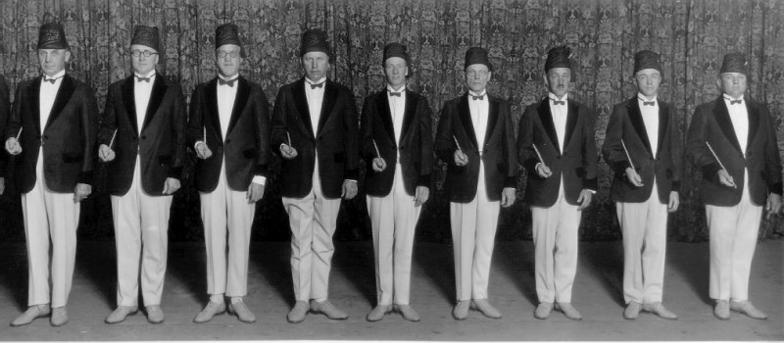
SCIOTS – Circa 1920
Note: The photo above was donated to the Pharaoh by SCIOT Galen Neidenfuehr (32), and is part of a collection of Sciots History that is being put together by the Parks family in the form of a “Book of Memories”. The publishing date is yet to be determined.
In 1905, a number of Masons met in Mission Masonic Temple, in the City of San Francisco, for the purpose of forming a social club, where Masons could get together on an equal footing, free from the restraint of the lodge room, yet organized for the purpose of furthering Masonic teachings and applying, in a practical way, in everyday business affairs, the teachings of the fraternity.
The idea was an instant success. It was recognized that such an Organization filled a long-felt want because it brought the brethren into close contact in their daily lives; fostering the true spirit of fraternity; caused men to forget their worries, troubles, and cares of life; made them look upon the brighter side of things; and gave them new hope and joy.
The slogan was: BOOST ONE ANOTHER! with the Moral…..
- Our neighbor’s assistance and cooperation in your business affairs
- The strong grip of a friend to help you over the rough places in life
- A kind word spoken in your behalf or your defense
- A watchful care over your brethren in their journey through life
- And a full measure of innocent amusement
- Is worth many times more to you while living, than the most beautiful requiem, over the most unctuous sermon, or the most elaborate pyramid over your remains when you are dead
SCIOTRY is friendship, fellowship, and cooperation, and the spirit of Boosting One Another through unity in all things.
Initially the organization was called the Boosters, which name was changed to Sciots on January 23, 1910: It retained as its slogan, “Boost One Another!” Its ceremonials are based on the practical democracy of the Greeks under the League of Neighbors (Amphictyony) as practiced on the rugged island of Scio and the legend of the island’s inhabitants, the Sciots sojourn to deliver the fruits of their native island to the Pharaoh of Egypt in about 1124 B.C., some sixty years after the fall of Troy.
The Officers of a Pyramid are Toparch, Mobib, Armeses, Pastaphori, Scribe, Chancellor, Marshal, Proclamator, Mazai, Klaschr, Chief of the Me, Sub-Chief, Standard Bearer, Neokori, Chief Musician. The Supreme Pyramid’s officers are Pharaoh, Supreme Mobib, Supreme Armeses, Supreme Pastophori, Supreme Klasher, three Supreme Trustees, Supreme Hierophant or Chaplain, Supreme Marshal, Supreme Standard Bearer, Supreme Neokori, and Supreme Chief of Me.
The Sciots Foundation Fund exists for the rehabilitation of underprivileged children, between the ages of two and fourteen years, no mater of what race, creed or color. The Sciots also have a Sunshine Fund for the dissemination of pleasure otherwise denied to underprivileged children.
Sciots History and Legend
Scio, so called by the Romans, and Chyos by the Greeks, is an island in the Aegean Sea, on the West Coast of Asia Minor. It is about thirty miles in length from North to South and varies in breadth from eight to fifteen miles. It is divided into a larger Northern and a smaller Southern part, called respectively Apanomeria and Katomeria.
The island is rugged and well deserves the description “craggy”, applied to it in the Homeric Hymn. Scio has always been noted for its excellent wines, figs and other fruits. The legend placed the following events about 1124 B.C., or sixty years after the fall of Troy. At that time the Sciots were Greeks, in whom the Grecian characteristics were most pronounced. They had no nobility . . . .
To Be a Sciot was itself Noble
They evinced a deep patriotism and love of Country as well as love for their homes. They were in spirit the most democratic of the neighboring tribes in which predominated not only their love for liberty and justice, but especially of equality. There was an association among the tribes of those neighboring islands, for the common worship of the same God.
These Associations were federal in character that is, while the members were independent in other matters, they were subject to a common central authority in all that concerned religious worship. Such a federal association was called an Amphictyony, that is, “A League of Neighbors”. more……….
